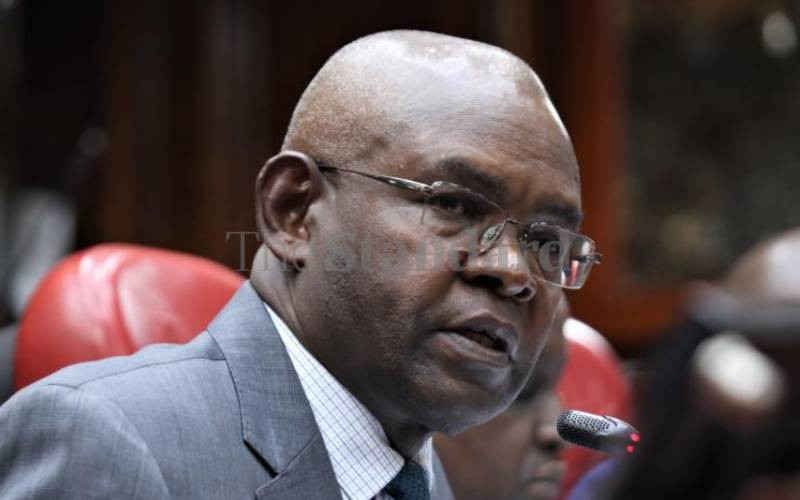
NAIROBI: Kenyans’ dream of cheaper loans will still be a mirage, at least for the next year, as the Government’s appetite for domestic loans to fund development projects remains.
Barely two months after the Government successfully issued a debut $2 billion (Sh176 billion) sovereign bond, Treasury is back in the local market borrowing money. It is looking to raise Sh10 billion through a two-year bond.
Many market watchers had expected the Government to stay away from borrowing locally so that Kenyans could enjoy cheaper loans from commercial banks, which are among the largest lenders to the State.
And so the timing of the Government’s decision to issue a two-year bond, where it will pay investors an interest rate of 10.793 per cent, has raised many eyebrows.
Pay a premium
The interest the Government is offering investors is priced above the newly introduced Kenya Bankers Reference Rate (KBRR), which is at 9.13 per cent.
The KBRR is the lowest rate banks can offer their loans at, but they need to add their profit margins, which could take interests as high as 17 per cent.
By pricing the two-year bond above the KBRR, many consider it is the Government’s way of showing investors it is willing to pay a premium to attract funds.
And since the Government is considered a safer bet when it comes to lending than ordinary Kenyans, many banks are likely to be interested in offering their cash at this rate of return.
This now means many commercial banks will extend loans to customers at nothing less than 10.793 per cent – the rate the Government is willing to pay.
The two-year bond offer opened on July 7 and closed last week on July 22. The results of its uptake come out Tuesday.
In a media advert, the Central Bank of Kenya (CBK) said the Sh10 billion would be used to finance part of the Government’s ambitious 2014/15 Sh1.8 trillion Budget, the first to be crafted by technocrats under the Jubilee Administration. The Government has a Budget deficit of Sh342.6 billion.
National Treasury Principal Secretary Kamau Thugge refuted the idea that the Government appears to have shifted goal posts as far as its financing sources are concerned.
He said the Government’s domestic borrowing envelope of Sh190.8 billion – which is much higher than the Sh107 billion borrowed from the domestic market last ear – would be reduced by the proceeds of the sovereign bond.
Stay informed. Subscribe to our newsletter
“There is no policy shift,” he said. “Instead of borrowing the full amount of Sh190.8 billion as per earlier expectations, it will be reduced by the equivalent use of the sovereign bond deposits.”
Last month, Kenya went out to borrow between $1.5 billion and $2 billion from the international debt market, the largest ever debut for any African country.
The Government, through the National Treasury, received orders for $8 billion (Sh701.8 billion) — an oversubscription of 300 per cent — with pension funds, insurers and sovereign wealth funds driving the bond orders.
Credit risk
The funds raised from the bond issue will be used to finance infrastructure projects, repay a $600 million (Sh52.6 billion) syndicated loan as well as bolster CBK’s forex reserves to stabilise the shilling exchange rate.
National Treasury Cabinet Secretary Henry Rotich remained upbeat that interest rates would soon start coming down, insisting the Government is not active in the money markets.
“We should be able to see interest rates coming down. In fact, rates on the 91-day Treasury Bills have already started going down because we are not in the market now,” he said.
According to Central Bank, the money market was relatively tight during the week ending July 25 owing to the payment of taxes and issuance of Treasury Bills.
The average interest rates on the 91-day Bills, 182-day Bills and 364-day Bills hovered around 8.69 per cent, 10.06 per cent and 10.33 per cent, respectively.
But despite attempts by policy makers and monetary authorities to control increasing interest rates and lower the costs of doing business, borrowers’ credit risk profiles and the Government’s unpredictable behaviour in the money markets are feared to be frustrating efforts to help Kenyans access cheaper loans.
Unlock funding
According to the latest statistics from Central Bank, the value of gross non-performing loans (NPLs) in the banking industry grew 6.9 per cent to Sh101.7 billion last month from Sh95.1 billion in March due to the spillover effects of high lending rates and challenges in the business environment.
Further, the International Monetary Fund (IMF) is set to audit Kenya’s economic progress in November this year in a move expected to unlock funding to support the country’s biggest ever spending plan.
But even as the institution considers extending a helping hand to the economy, whose growth prospects remain shrouded in uncertainty, concerns are being raised over the growing public debt.
The IMF said the Government ought to strike a balance between its domestic and external borrowing requirements to avoid destabilising domestic macroeconomic conditions, such as the interest rate, shilling exchange rate and inflation.
Mr Ragnar Gudmundsson, IMF Kenya’s resident representative, said the country’s economic reforms would be assessed to determine its suitability for budgetary support in the current financial year.
Among the key economic parameters to be reviewed are the country’s fiscal policy, sustainability of public finances in the medium term, sustainability of public debt and state of monetary policy.
Though most of Kenya’s public external debt remains on concessional terms, its commercial component increased to about 15 per cent by June 2014, with the Eurobond taken into account, according to the World Bank.
“We shall also look at fiscal policy management in terms of mobilisation of resources. The progress will be discussed between the Government of Kenya and IMF between October and November this year,” Mr Gudmundsson told Business Beat last week.
Benchmark rate
Debate over the high interest rates charged by commercial banks on loans has culminated in the introduction of the KBRR in the hopes that the benchmark rate will inform a new regime of stable shilling exchange rates and low interest rates conducive for private investment.
The lenders have also begun implementing the Annual Percentage Rate (APR) pricing mechanism, which allows borrowers to compare different loan costs across various banks based on standardised parameters and a common computation model.
The APR is one of the industry interventions spearheaded by the Kenya Bankers Association (KBA) in collaboration with the Central Bank.
“As an industry, we are enhancing pricing disclosures to enable bank customers to make more informed choices. This is one of the mechanisms embraced by banks to address issues relating to easing access to credit,” said Mr Habil Olaka, KBA’s chief executive.
According to Mr Olaka, the APR mechanism, which became effective on July 1, would promote pricing transparency and not only stimulate competitive loan interest rates, but also consumer protection by standardising disclosures during credit application processes.
The APR takes into account the interest rate component, bank charges and fees, and third-party costs, including legal fees, insurance costs, valuation fees and Government levies.
Previously, banks were only required to provide loan applicants with a breakdown of the Total Cost of Credit (bank charges and third-party costs associated with the loan facility); and a Loan Repayment Schedule in line with the Central Bank Prudential Guidelines.
Liquidity challenges
Official data shows that between December 2012 and April 2014, lending rates fell just 144 basis points — about half the 250 basis-point decline in the Central Bank Rate, which is the lowest interest CBK charges on loans to banks.
This has been attributed to liquidity challenges in the banking system brought about by slow payment of Government contracts, which has choked the transmission of reductions in the CBR to lower lending rates.
[email protected]
 The Standard Group Plc is a
multi-media organization with investments in media platforms spanning newspaper
print operations, television, radio broadcasting, digital and online services. The
Standard Group is recognized as a leading multi-media house in Kenya with a key
influence in matters of national and international interest.
The Standard Group Plc is a
multi-media organization with investments in media platforms spanning newspaper
print operations, television, radio broadcasting, digital and online services. The
Standard Group is recognized as a leading multi-media house in Kenya with a key
influence in matters of national and international interest.
 The Standard Group Plc is a
multi-media organization with investments in media platforms spanning newspaper
print operations, television, radio broadcasting, digital and online services. The
Standard Group is recognized as a leading multi-media house in Kenya with a key
influence in matters of national and international interest.
The Standard Group Plc is a
multi-media organization with investments in media platforms spanning newspaper
print operations, television, radio broadcasting, digital and online services. The
Standard Group is recognized as a leading multi-media house in Kenya with a key
influence in matters of national and international interest.









